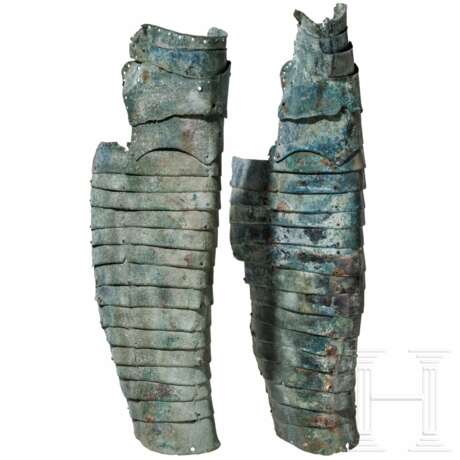Römische Lamellen-Beinschienen eines Panzerreiters (catafractarius), 3. Jhdt.
06.05.2023 10:00UTC +01:00
Classic
Starting price
17000EUR € 17 000
| Auctioneer | Hermann Historica |
|---|---|
| Event location | Germany, Grasbrunn / München |
| Buyer Premium | 25 % |
Archive
The auction is completed. No bids can be placed anymore.

ID 946726
Lot 30 | Römische Lamellen-Beinschienen eines Panzerreiters (catafractarius), 3. Jhdt.
Estimate value
€ 17 000
Panzerungen aus Lamellen waren im Römischen Heer häufig anzutreffen. Neben dem berühmten Schienenpanzer (lorica segmentata) sind auch Funde von Armschutzvorrichtungen aus Lamellen (manica) für die Schwerthand als Originalfunde bekannt, deren Konstruktion stark an vorliegende Beinschienen erinnert. Dargestellt sind solche "manicae" auf Metopen des Siegesdenkmals von Adamklissi aus trajanischer Zeit. Beinschienen aus Lamellen sind bisher im Original nicht erhalten. Übliche Kavallerie- und Infanterieeinheiten trugen zahlreich belegte zweiteilige Beinschienen mit separatem Knieschutz. Beinschienen aus Lamellen sind jedoch aus bildlichen Darstellungen bekannt, die schwere Lanzenreiter mit Ganzkörperpanzerungen zeigen, darunter das berühmte Graffito aus Dura Europos. Auf letzterem sind eindeutig die gesamte Wade umschließende Beinschienen aus Lamellen dargestellt. Panzerreiter nach mittelasiatischem Vorbild spielten in der römischen Armee im Verlauf des 3. Jhdts. und in der Spätantike eine wichtige Rolle als schwere Kavallerie.
Provenienz: Süddeutsche Privatsammlung, erworben in den 90er Jahren im Münchner Kunsthandel (M. H.).
A pair of Roman lamellar greaves of an armoured rider (catafractarius), 3rd century
A pair of matching greaves made of anatomically shaped, movable bronze lamellae. The right example consists of 19 lamellae, the left of 20. The lower 15 lamellae of each example arranged horizontally, connected on both sides with two rows each and on the shin with a row of rivets made of iron. On the outside, along the rows of rivets, traces or imprints of strips (of iron sheet or leather?) connecting the rivets are partially preserved. The construction adapts anatomically to the slightly outwardly curved shin and becomes wider towards the top to enclose the calves. Above this construction there are four lamellae on the example for the right leg and five lamellae on the example for the left leg, which served as knee protection and were more flexible. The reason for the different design remains unclear (different leg lengths? Adaptation to injury?). However, there is no doubt that the two greaves belong together and are complete. The two lower lamellae enclosing the knee are differently shaped. The lower one at the bottom with two curved cut-outs and the one above with one concave cut-out each at the top and bottom. The two and three lamellae above are again of the same width. The entire upper rim and the lateral edges of the construction perforated at intervals of approx. 1 - 1.5 cm, probably to attach an inner lining. Olive green patina with minimal incrustations. On the left specimen a partially shimmering metallic background. Excellent state of preservation without missing parts or additions. Height of the right greave 45 cm, of the left 49 cm.
Armour made of lamellae was frequently encountered in the Roman army. In addition to the famous splint armour (lorica segmentata), finds of arm protection devices made of lamellae (manica) for the sword arm are known as original finds, the construction of which is strongly reminiscent of the here presented greaves. Such "manicae" are depicted on metopes of the victory monument of Adamklissi from the Trajan period. So far, greaves made of lamellae have not been preserved in the original. Common cavalry and infantry units wore two-piece greaves with separate knee protection, that exist in many items. However, greaves made of lamellae are known from pictorial representations showing heavy lancers with full body armour, including the famous graffito from Dura Europos. The latter clearly shows lamellar greaves enclosing the entire calf. Central Asian-style armoured horsemen played an important role as heavy cavalry in the Roman army in the course of the 3rd century and in late antiquity.
Provenance: South German private collection, acquired in the Munich art trade (M.H.) in the 90s.
Condition: I - II
| Place of origin: | Roman Empire |
|---|
| Place of origin: | Roman Empire |
|---|
| Address of auction |
Hermann Historica Bretonischer Ring 3 85630 Grasbrunn / München Germany | ||||||||||||||
|---|---|---|---|---|---|---|---|---|---|---|---|---|---|---|---|
| Preview |
| ||||||||||||||
| Phone | +49 (0)89 5472 649 0 | ||||||||||||||
| Fax | +49 (0)89 5472 64999 | ||||||||||||||
| Buyer Premium | 25 % | ||||||||||||||
| Conditions of purchase | Conditions of purchase | ||||||||||||||
| Business hours | Business hours
|


